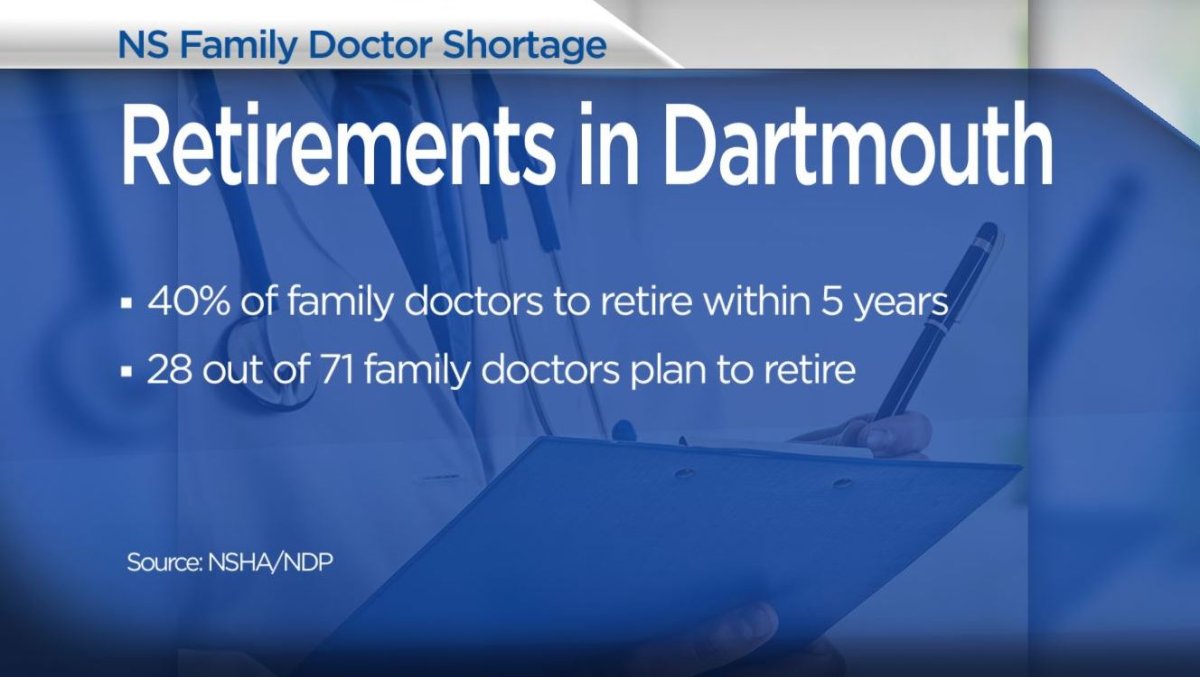The head of the organization charged with delivering health care to Nova Scotians called the shortage of family doctors in the province a “major problem.”

Health authority CEO and President Janet Knox made the statement to journalists after updating a legislative committee about physician recruitment, on Wednesday.
“We do have a problem,” she said. “We have a major problem that we are saying is job one for the health system of Nova Scotia.”
40 per cent of Dartmouth family doctors will retire within five years
According to Doctors Nova Scotia, 55 per cent of physicians in the province are over the age of 50. The numbers show a retirement boom is coming according to the group.
The organization’s CEO Nancy MacCready-Williams called it a “looming situation.”
In Dartmouth, for example, the health authority confirmed that 40 per cent of the community’s family doctors are retiring within five years. According to the NDP that works out to 28 doctors planning to retire out of a total of 71 practicing family physicians.
Dartmouth South MLA Claudia Chender said suggested her region is the canary in the coal mine.
“I think Dartmouth is an example of what’s happening across the province as a whole,” she said. “But in a very acute manner.”
There are currently 72 openings for full-time family doctors across the province. The health authority says that includes current vacancies and future retirements.
Goal is to recruit more than 51 family doctors per year

Get weekly health news
The health authority needs to recruit 51 family doctors each year to keep up with demand, according to the current physician resource plan.
Last year, the health authority fell short of that goal — it recruited 43 family doctors in 2016-17.
This year, it says it’s on track. So far, 26 new family doctors have been recruited and are in place. The health authority’s vice-president of medicine, Dr. Lynne Harrigan, said another 11 recruits have accepted offers and are expected to be on the ground by the summer.
“We will get as many doctors as we can,” Harrigan told the committee. “I would take 100 family doctors.”
It’s also likely the target of 51 doctors per year is too low, according to deputy health minister Denise Perret. “We think we need to be higher,” she said.
An updated physician resource plan is expected “early in the new year,” Perret said.
42,198 Nova Scotians are on family doctor wait list
42,198 Nova Scotians were on the provincial wait list as of Dec. 1.
Over the first year of the list, thousands more have been added to the list than taken off. Numbers from the health authority show 6,428 people who were on the wait list have found a family doctor.
The health authority says the numbers on the wait list show 4.6 per cent of Nova Scotians don’t have a family doctor. That’s a dramatic difference from the most recent Statistics Canada numbers that show 11 per cent of Nova Scotians (over the age of 12) don’t have a family doctor.
Asked about that gap at the committee, Harrigan said the health authority tracks the information from Statistics Canada. But she said its much less useful than the hard data from the waitlist because they are able to track the people on the wait list.
“It’s a number to track,” Perret added. “I agree with Dr. Harrigan, its meaning is limited in how it helps us plan.”
How long should you expect to sit on the family doctor wait list?
Neither the health authority or the health department could say how long people waiting for a doctor will have to wait.
Asked if the wait could be many years, Perret said: “No, I don’t agree with that.” But she couldn’t point to any information to show what it would be.
“We’re hopeful that people are not on it for very long,” she said.
She suggested more changes are being made that could speed up recruiting. For example, changing incentives for family doctors.
Approximately 15 per cent of people who were on the waitlist have been placed in the first year.










Comments